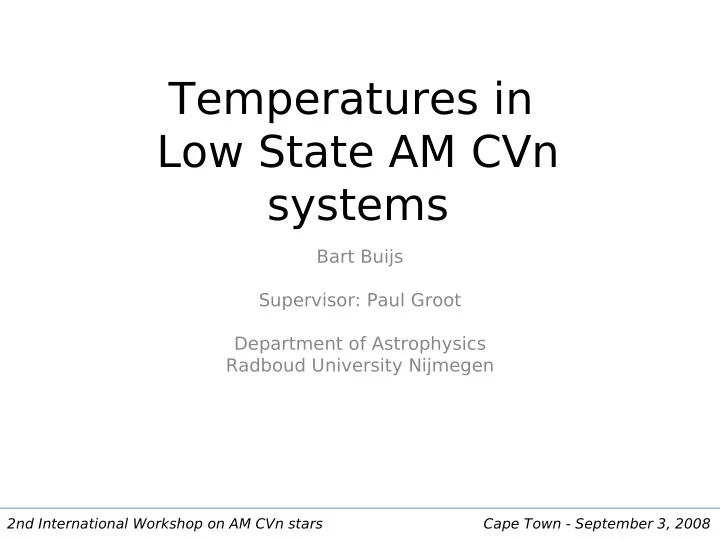

Temperatures in Low State AM CVn systems Bart Buijs Supervisor: Paul Groot Department of Astrophysics Radboud University Nijmegen 2nd International Workshop on AM CVn stars Cape Town - September 3, 2008
Question What can the temperature of the accretor in an AM CVn system tell us about the donor and the formation channel? 2nd International Workshop on AM CVn stars Cape Town - September 3, 2008
Contents 1. Accretor reheating 2. Fitting Koester DB models 3. Fitting DB + BB models 4. Results 5. Conclusions 2nd International Workshop on AM CVn stars Cape Town - September 3, 2008
Accretor reheating Bildsten et al. 2006 2nd International Workshop on AM CVn stars Cape Town - September 3, 2008
Fitting Koester DB models Example: SDSS J1240 Porb = 37.8 min Average spectrum from Roelofs et al. 2005 Koester DB model 2nd International Workshop on AM CVn stars Cape Town - September 3, 2008
Fitting Koester DB models We take a grid of Koester DB with: 10 000 K < Tdb < 50 000, Log(g) = 7.5 or 8.0 or 8.5, take Rwd = 0.0123 Rsun , and use D as free parameter. 2nd International Workshop on AM CVn stars Cape Town - September 3, 2008
Fitting Koester DB models Residuals: spectrum - model 2nd International Workshop on AM CVn stars Cape Town - September 3, 2008
Fitting DB + BB models New parameters: 500 < Tbb < 5000, 1E-3*Awd < Abb < Arl1 2nd International Workshop on AM CVn stars Cape Town - September 3, 2008
Fitting DB + BB models 2nd International Workshop on AM CVn stars Cape Town - September 3, 2008
Results: SDSS J1240 Best fit: T = 18 000K, log(g) = 8.0, D = 546 pc 16 000 K < T < 22 000 K, log(g) ≥ 8.0, D=546 ±107 2nd International Workshop on AM CVn stars Cape Town - September 3, 2008
Results: SN 2003aw Spectrum from Roelofs et al. 2006 2nd International Workshop on AM CVn stars Cape Town - September 3, 2008
Results: SDSS J0926 2nd International Workshop on AM CVn stars Cape Town - September 3, 2008
Results: CP Eri Spectrum from Marsh 2nd International Workshop on AM CVn stars Cape Town - September 3, 2008
Results: overview (Tlit from Bildsten et al. 2006) System P T lit Spectru T (kK) Log D (pc) name (min) (kK) m from (g) V 803 Cen 26.9 14 - ? ? ? SDSS J0926 28.3 18 SDSS 14 ? 208 ± 89 CP Eri 28.4 17 Marsh 12 ≤ 8.0 419 ± 130 SN 2003aw 33.8 17 Roelofs 18 ≥ 8.0 1047± 183 ? - SDSS ≥ 13 ? ? SDSS J0129 2QZ J1427 ? - Woudt 13 ≤ 8.0 325 ± 141 SDSS J1240 37.4 17 Roelofs 18 ≥ 8.0 546 ± 107 SDSS J1208 ? - SDSS 12 ? 297 ± 160 SDSS J1411 46.0 - SDSS 15 ≥ 8.0 430 ± 84 56.2 - SDSS 13 ? 662 ± 353 SDSS J1552 2nd International Workshop on AM CVn stars Cape Town - September 3, 2008
Conclusions Uncertainties on temperatures are too high to draw strong conclusions about the accretion history, i.e. the donor entropy/formation channel, but SDSS J0926 and CP Eri look relatively cold and light WD channel ? SDSS J1240 and SN2003 aw relatively hot and heavy He Star channel ? Hotter accretors look heavier as well Quality of spectra too low to fit DB + BB credibly To find a trace of the donor from a multicomponent fit we need wider (say 300 – 1900 nm) intermediate resolution spectra X-shooter ! 2nd International Workshop on AM CVn stars Cape Town - September 3, 2008
Recommend
More recommend